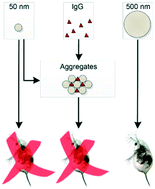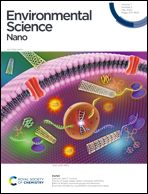Controlled protein mediated aggregation of polystyrene nanoplastics does not reduce toxicity towards Daphnia magna†
Abstract
Microplastics have recently become a growing environmental issue, whereas the smaller fractions, nanoplastics, have received less attention. Due to their small size, nanoplastics may affect organisms differently and potentially more severely than larger microplastics. In natural environments nanoplastics also interact with organic material and form larger aggregates, which may, potentially, reduce their toxicity as they grow in size. We tested the change in toxicity towards Daphnia magna by controlling the size of the aggregates of positively charged 50 nm polystyrene nanoplastics, which are highly toxic as single particles. We show that although 200 to 500 nm nanoplastics are not toxic, aggregates of 50 nm nanoplastics in the same size range are at least as toxic as the free, 50 nm, nanoplastics. Hence, an increase in size through aggregation, a process likely to occur as nanoparticles enter natural ecosystems, does not reduce toxicity. In a broader context this finding provides a firm basis for societal decision making regarding the potency of nanoparticles as they enter natural ecosystems.



 Please wait while we load your content...
Please wait while we load your content...